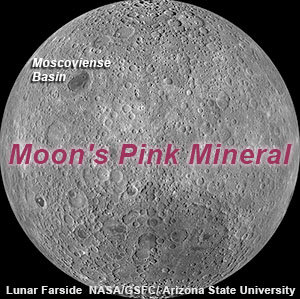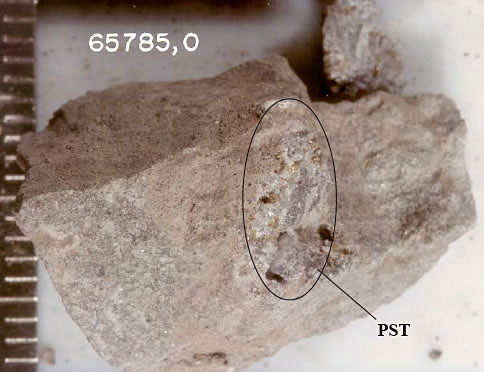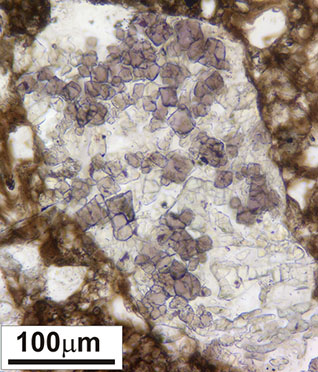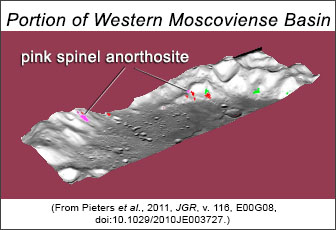Citation: Martel, L. M. V. and Taylor, G. J. (December, 2014) Moon's Pink Mineral, PSRD, http://www.psrd.hawaii.edu/Dec14/lunar-pink-spinel.html.
 |
December 23, 2014 New 2016 reference added.
Moon's Pink Mineral
--- Remote sensing detections of pink spinel anorthosite are compared with sample analyses and experimental results to learn more about the lunar crust.
Written by Linda M. V. Martel and G. Jeffrey Taylor
Hawai'i Institute of Geophysics and Planetology
Since the 2010 remote-sensing discovery of lunar regolith rich in Mg-Al spinel on the rims and central peaks of impact craters and inner rings of basins on the Moon, researchers have been designing experiments to better understand the origin and formation history of spinel-rich rocks and what they mean for the construction of the lunar crust. The newly detected rock type is referred to as pink spinel anorthosite, or PSA, due to high plagioclase and low abundance (<5%) of mafic minerals such as olivine and pyroxene. Two recent studies tested specific hypotheses of PSA production on the Moon. Juliane Gross (American Museum of Natural History and the Lunar and Planetary Institute, LPI) and colleagues at the LPI, University of Hawaii, and NASA Johnson Space Center conducted experiments to model the crystallization of spinel in impact melts from impact events. Tabb Prissel (Brown University) and colleagues from Brown conducted experiments to model a plutonic formation of spinel from magma-wallrock interactions. In each study, comparisons of the remote sensing data with Apollo lunar samples or lunar meteorites were crucial for testing the PSA formation hypotheses with the experimental results. Definitive answers aren't in yet. PSA could form from impact melting of the right target rocks. Equally likely is PSA formation by reaction of basaltic magma and crust. One big unknown is the effect space weathering has in determining the amount of spinel in the PSA.
References:
- Gross, J., Isaacson, P. J., Treiman, A. H., Le, L., and Gorman, J. K. (2014) Spinel-rich Lithologies in the Lunar Highland Crust: Linking Lunar Samples with Crystallization Experiments and Remote Sensing, American Mineralogist, v. 99, p. 1849-1859, doi: 10.2138/am-2014-4780. [ abstract ]
- Prissel, T. C., Parman, S. W., Jackson, C. R. M., Rutherford, M. J., Hess, P. C., Head, J. W., Cheek, L., Dhingra, D., and Pieters, C. M. (2014) Pink Moon: The Petrogenesis of Pink Spinel Anorthosites and Implications Concerning Mg-suite Magmatism, Earth and Planetary Science Letters, v. 403, p. 144-156, doi: 10.1016/j.epsl.2014.06.027. [ abstract ]
- PSRDpresents: Moon's Pink Mineral --Short Slide Summary (with accompanying notes).
A Review of Lunar Spinels—From the Apollo Rock Collection
Pink-hued spinel (a magnesium aluminum oxide mineral) was first reported in the Apollo lunar sample collection in 1973 though it was, and is, a rare find in these samples. Gross and coauthors list 18 lunar samples containing between <1 to 30% Mg-Al spinel. These samples include the lunar meteorite ALHA81005 [Data link from the Meteoritical Bulletin] and one sample from the Soviet Luna Program. Analyses show that most lunar spinels are the iron-rich variety (FeCr2O4 called chromite) or iron-titanium variety (Fe2TiO4 called ulvöspinel). The spinels are most commonly found in troctolites—a type of highlands magnesian suite (Mg-suite) rock composed of cumulates of plagioclase plus olivine. (See this PSRD article for more about Mg-suite and lunar highlands rocks: Unraveling the Origin of the Lunar Highlands Crust.) Prissel and coauthors point out an important fact that the spinel-bearing samples in the lunar collection, without exception, contain greater than 8 volume% of olivine ± pyroxene.
The clast of pink spinel troctolite, shown in the photo on the left, in Apollo sample 65785 is 5% Mg-Al spinel, 30% olivine, 65% plagioclase, and is zoned in chromium content from 2.6-12.6% from the center outward (data from the Lunar Sample Compendium). The clast found in lunar meteorite ALHA81005, shown in the photo on the right, is ~30 vol% Mg-Al spinel and ~20 vol% olivine + pyroxene as reported in 2011 by Juliane Gross and Allan Treiman (Lunar and Planetary Institute).
 |
 |
| [ LEFT ] NASA photo of an Apollo 16 rake sample, 65785, with a clast of pink spinel troctolite, labeled PST, set within recrystallized impact melt. Scale bar on the left edge is in millimeters. NASA photo S72-48821. [ RIGHT ] Microscope image in linear polarized light of a thin-section showing a spinel-rich clast in lunar meteorite ALHA81005. The pink/purple grains are spinel. The clear/white minerals in the clast are olivine and plagioclase. Image from Gross and Treiman, 2011; see reference list.) | |
Discovery of New Lunar Rock Type
![]() New studies have been sparked by the discovery, in orbital remote sensing data, of a different kind of rock type on the surface of the Moon— spinel-rich, plagioclase-rich, with no to low detectable olivine and pyroxene (<5%).
New studies have been sparked by the discovery, in orbital remote sensing data, of a different kind of rock type on the surface of the Moon— spinel-rich, plagioclase-rich, with no to low detectable olivine and pyroxene (<5%).
The Chandrayaan-1 spacecraft, launched in 2008 by the Indian Space Research Organization (ISRO), carried 11 scientific instruments including the NASA-supported guest instrument Moon Mineralogy Mapper, M3. During the 10 months of Chandarayaan-1 operation, the M3 imaging spectrometer acquired data in 85 spectral bands between 400—3000 nm (visible into near-infrared) at a resolution of 140 meters/pixel.
In the 2011 discovery paper, M3 Principal Investigator Carle Pieters (Brown University) and the science team based their findings on the M3 compositional data for the Moscoviense Basin (27oN, 146oE) located in the Feldspathic Highland Terrane (FHT) on the lunar farside (for more about the FHT see PSRD article: A New Moon for the Twenty-First Century). They found areas (a few kilometers in dimension at most) on the western inner ring of the basin with spectral signatures of Mg-Al-rich spinel; locations shown in the image below. Unlike the spinel in the Apollo samples, the team did not see a spectral signature for chromite. Moreover, they found that the areas consisting of Mg-Al spinel are lacking or are low in other mafic minerals (<5% olivine, pyroxene), which distinguishes them significantly from previously identified spinel-bearing lunar samples. Pieters and coauthors named the new rock type pink spinel anorthosite, or PSA.
 |
| In this 3-D perspective view (derived from LOLA data and shown with vertical exaggeration of 5x) Pieters and coauthors show, in bright pink, the locations in the Moscoviense Basin where M3 data indicate pink spinel anorthosite. The unique composition was not recognized in remote sensing data or in the lunar samples previous to this discovery in M3 data. The other colors on the image are locations of other compositionally distinct rock types mapped by Pieters and colleagues; high concentrations of orthopyroxene in red and olivine in green. See their 2011 discovery paper for details. |
Since the initial discovery, different groups of researchers have identified pink spinel anorthosite spectral signatures in 23 more areas (a few hundred meters in dimension) on the rims, walls, and central peaks of impact craters and inner rings of basins on the lunar farside and nearside. Pieters and colleagues provide a list and map of confirmed M3-identified locations of pink spinel anorthosite in a 2014 paper (see reference list). In spite of their small, individual sizes, these widespread exposures have significance for the construction of the lunar crust.
How Did Pink Spinel Anorthosite Form on the Moon?
Making pink spinel anorthosite requires formation of a lot of Mg-Al spinel, usually not particularly abundant in lunar samples. It has to crystallize in sufficient quantity or accumulate in a magma body. The papers led by Prissel and Gross report high-temperature experiments to examine the problem from the lunar surface to the base of the crust. Assuming that the rocks formed from magmas and are not merely mechanical mixtures, the trick is to produce a magma that has a chemical composition just right to crystallize all that spinel. Because the pink spinel anorthosites appear to consist of nothing but spinel and plagioclase feldspar, this means that the magma must crystallize spinel before or along with plagioclase. Olivine could crystallize first, but it would have to be totally removed (for example, by sinking to form a dunite) before the spinel-rich rocks formed. However, you can't remove too much olivine because it causes the ratio of iron to magnesium to increase in the magma, resulting in too much iron in the spinel, and darkening its pinkish color.
One way to produce the right composition is to melt a spinel-producing mixture of olivine-rich and feldspar-rich rocks. Melting requires a lot of heat, and that happens in the mantle, not the crust where the olivine and pyroxene bearing rocks reside. Juliane Gross and co-workers suggest that the pink spinel anorthosites formed by impact melting of a target consisting of olivine-rich and plagioclase-rich rocks. Large impacts are mighty energetic, so plenty of heat and impact-magma is produced, and the pink spinel anorthosites appear to reside in crater central peaks and basin rings.
To test the impact-melting idea, Gross and coworkers melted two reasonable starting compositions. One had the composition of the pink spinel troctolite in Apollo sample 65785 (pictured above, left). The other had a chemical composition modeled after that of lunar meteorite ALHA81005, a good representation of the lunar highlands crust. After concocting the starting materials from powders, they heated the samples to different temperatures. They held the temperature constant in each run for a day or two, and then dropped the sample into water to quench it, thereby preserving the record of what minerals were present at the high temperature. The experiments were done at one atmosphere pressure at oxidation conditions like those inside the Moon. The results show that spinel appears to be a reluctant crystallizer. The ALHA81005 composition did not form any spinel at all. Not unexpectedly, the spinel troctolite composition did form spinel (see examples below), but no more than 8 wt%, far from the 20-30 wt% in pink spinel anorthosite estimated by previous studies. Gross and colleagues conclude that impact melting of typical lunar highlands crust, even if already containing spinel, would not lead to formation of the pink spinel anorthosites, unless some process such as crystal sinking led to higher concentrations of spinel.
 |
| Backscattered electron images of two of the products from experiments run by Gross and colleagues with a starting composition of the pink spinel troctolite in Apollo sample 65785. [ LEFT ] the experiment at 1300oC, [ RIGHT ] the experiment at 1350oC. Shown are Sp=spinel, Plag=plagioclase, and glass. |
Tabb Prissel and colleagues examined the possibility that the pink spinel anorthosites formed by reaction within the lunar crust between basaltic magma and anorthosite (rocks made predominately of plagioclase feldspar). They used two basalt compositions, one corresponding to the famous Apollo 15 green glass and the other corresponding to a hypothetical parent magma to the lunar magnesian suite of rocks. The idea is that these magnesium-rich magmas would intrude the anorthosite crust, reacting with the wall rock to produce a zone rich in spinel (aluminum from the anorthosite, magnesium from the basaltic magma, essential ingredients in the recipe for Mg-Al spinel). This good idea needed to be tested experimentally, so Prissel and colleagues made pressed, sintered powers of calcium-rich plagioclase (a suitable lunar anorthosite analog), green glass, and magnesian suite parent, assembled experimental charges consisting of anorthosite on one side and one of the basaltic compositions on the other side, and heated them in furnaces at pressures ranging from 0.05 GPa (about 500 times atmospheric pressure) to 1.05 GPa (about 10,500 times atmospheric pressure).
 |
| [ LEFT ] Backscattered electron image of a product from experiments run by Prissel and colleagues at a temperature of 1400oC. The starting materials were anorthite (dark material at the top of the image labelled An) and glass with the composition of Apollo 15 volcanic green glass (grey areas at the bottom left and right labelled liq). A region containing abundant spinel (labelled Sp + liq) developed between the anorthite and basaltic melt, indicating that reaction of a basaltic magma with anorthosite in the lunar crust could produce spinel-rich rocks. [ RIGHT ] Compositions of spinels produced by Tabb Prissel's experiments. Cr# is chromium/(chromium+aluminum), in molar percent. Mg# is magnesium/magnesium+iron), also in mole percent. Shaded areas show regions for spinels in mare basalts, pink spinel troctolites from the lunar highlands, and (in dark pink) spinels in pink spinel anorthosites as determined by remote sensing using M3 data. The spinels produced in the experiments using the magnesian suite parent magma and anorthosite produced spinels (open circles) with compositions like those in pink spinel anorthosites. In contrast, spinels produced in experiments involving anorthosite and green glass magma produced spinels (green circles) with lower Mg# and slightly lower Cr# than those in pink spinel anorthosite. Overall, the experiments suggest that reaction between magnesian suite magma and anorthosite is a reasonable mechanism for producing pink spinel anorthosites. |
The results confirm that reaction between basalt melt and anorthosite can change the composition of the melt so that it precipitates spinel, as shown in the image above. The compositions of the spinels produced in the experiments using the hypothetical magnesian suite parent magma are close to those estimated remotely for the pink spinel anorthosites. The spinel compositions produced in experiments involving the green glass magma do not match as well. The important point is that basaltic magma can react with anorthosite crust to form a magma rich in both feldspar and spinel. Such reactions could take place when basaltic magmas intruded the anorthositic crust, with pink spinel anorthosite formed at the boundary between the anorthosite and the basaltic magma, as shown below.
 |
| Schematic diagram showing the idea, tested by Prissel and colleagues, that magnesium-rich magmas intruded the anorthosite crust and reacted with the wall rock to produce a zone rich in pink spinel anorthosite. |
Prissel and colleagues point out that the pink spinel anorthosites occur on both the near and farside of the Moon. If they all formed by reaction between anorthosite crustal rocks and magnesian suite magmas, Prissel suggests that the occurrence of pink spinel anorthosites might be a marker for intrusion of Mg-suite magmas on the farside of the Moon. Most magnesian suite rocks occur inside or nearby the Procellarum KREEP Terrane on the nearside (see PSRD article: A New Moon for the Twenty-First Century). However, Hiroshi Takeda (Chiba Inst. of Technology, Japan) and colleagues showed the presence of spinel-rich troctolite (olivine-plagioclase rock) and magnesian anorthosite in lunar meteorite Dhofar 489 [Data link from the Meteoritical Bulletin], which is almost certainly from the farside. They suggest that these lithologies derived from Mg-suite magmatism on the farside. Prissel and coworkers support this concept, suggesting that Mg-suite magmatism was a global phenomenon. In contrast to nearside magnesian rocks, the Dhofar 489 farside rock is not rich in KREEP, and the assumption is that farside PSA could also be KREEP-poor. This has led Prissel and colleagues to propose that the presence of all those trace elements that concentrated to make KREEP were not necessarily required to produce magnesian suite magmas. These important, speculative ideas are just the beginning of a long process of fully understanding and making sense of pink spinel anorthosites. Until we get more of the right meteorites or samples from the farside, the PSAs may play an important role in testing the idea of non-KREEPy magnesian magmatism on the lunar farside.
How Much Spinel is in Pink Spinel Anorthosite?
Determining how much spinel is in the pink spinel anorthosite is important to help understand how this newly-identified lunar rock formed. Interpretations of spinel abundance based on M3 reflectance spectra depend, in part, on details such as the strength of absorption bands in the spectra and on mineral mixing models that best match the spectra. Preliminary studies suggest 20-30 wt% spinel with plagioclase is a reasonable estimate. As highlighted above, experimental results do and don't create spinels with compositions and abundances similar to the M3 characteristics of spinel in pink spinel anorthosite. The work by Gross and coauthors showed that certain experimental conditions can match M3 PSA spectra with <8 wt% spinel, yet they caution that the experiments did not evaluate the effects of space weathering, which is known to weaken absorption bands. The spinel signal could have been stronger, hence more spinel, before the space weathering. As the pink spinel anorthosite in Moscoviense Basin appears old—Pieters and coauthors in the 2011 discovery paper determined the regolith here is as well developed as regional regoliths—understanding the effects of space weathering on PSA may be crucial to accurately interpret the M3 spectra. Exciting work is ongoing to understand these spinel-rich rocks and how they relate to the composition and construction of the lunar crust.
- PSRDpresents: Moon's Pink Mineral --Short Slide Summary (with accompanying notes).
- New Reference: Prissel, T. C., Parman, S. W., and Head, J. W. (2016) Formation of the Lunar Highlands Mg-suite as Told by Spinel, American Mineralogist, v. 101, p. 1624-1635, doi: 10.2138/am-2016-5581. [ abstract ]
- Dhingra, D., Pieters, C. M., Boardman, J. W., Head, J. W., Isaacson, P. J., and Taylor, L. A. (2011) Compositional Diversity at Theophilus Crater: Understanding the Geologic Context of Mg-spinel Bearing Central Peaks, Geophysical Research Letters, v. 38, L11201, doi: 10.1029/2011GL047314. [ abstract ]
- Gross, J., Isaacson, P. J., Treiman, A. H., Le, L., and Gorman, J. K. (2014) Spinel-rich Lithologies in the Lunar Highland Crust: Linking Lunar Samples with Crystallization Experiments and Remote Sensing, American Mineralogist, v. 99, p. 1849-1859, doi: 10.2138/am-2014-4780. [ abstract ]
- Gross, J. and Treiman, A. H. (2011) Spinel-rich Lithology in Lunar Meteorite ALHA81005: Origin and Possible Connection to M3 Observations of the Farside Highlands, Journal of Geophysical Research, v.116, E10009, doi: 10.1029/2011JE003858. [ abstract ]
- Martel, L. M. V. (2010) Unraveling the Origin of the Lunar Highlands Crust, Planetary Science Research Discoveries, http://www.psrd.hawaii.edu/Sept10/highlands-granulites.html
- Pieters, C. M., Donaldson Hanna, K., Cheek, L., Dhingra, D., Prissel, T., Jackson, C., Moriarty, D., Parman S., and Taylor, L. A. (2014) The Distribution of Mg-spinel Across the Moon and Constraints on Crustal Origin, American Mineralogist, v. 99, p. 1893-1910, doi: 10.2138/am-2014-4776. [ abstract ]
- Pieters, C. M. and 26 others (2011) Mg-spinel Lithology: A New Rock Type on the Lunar Farside, Journal of Geophysical Research, v. 116, E00G08, doi: 10.1029/2010JE003727. [ abstract ]
- Prissel, T. C., Parman, S. W., Jackson, C. R. M., Rutherford, M. J., Hess, P. C., Head, J. W., Cheek, L., Dhingra, D., and Pieters, C. M. (2014) Pink Moon: The Petrogenesis of Pink Spinel Anorthosites and Implications Concerning Mg-suite Magmatism, Earth and Planetary Science Letters, v. 403, p. 144-156, doi: 10.1016/j.epsl.2014.06.027. [ abstract ]
- Prinz, M., Dowty, E., Keil, K., and Bunch, T. E. (1973) Spinel Troctolite and Anorthosite in Apollo 16 Samples, Science, v. 179, p. 74-76, doi:10.1126/science.179.4068.74. [ abstract ]
- Taylor, G. J. (2000) A New Moon for the Twenty-First Century, Planetary Science Research Discoveries, http://www.psrd.hawaii.edu/Aug00/newMoon.html
- Takeda H., Yamaguchi, A., Bogard, D. D., Karouji, Y., Ebihara, M., Ohtake M., Saiki, K., and Arai, T. (2006) Magnesian Anorthosites and a Deep Crustal Rock from the Farside Crust of the Moon, Earth and Planetary Science Letters, v. 247, p. 171-184, doi: 10.1016/j.epsl.2006.04.004. [ abstract ]
- The Lunar Sample Compendium http://curator.jsc.nasa.gov/Lunar/lsc/index.cfm
|
|
[ About PSRD | Archive | CosmoSparks | Search | Subscribe ] [ Glossary | General Resources | Comments | Top of page ] |
